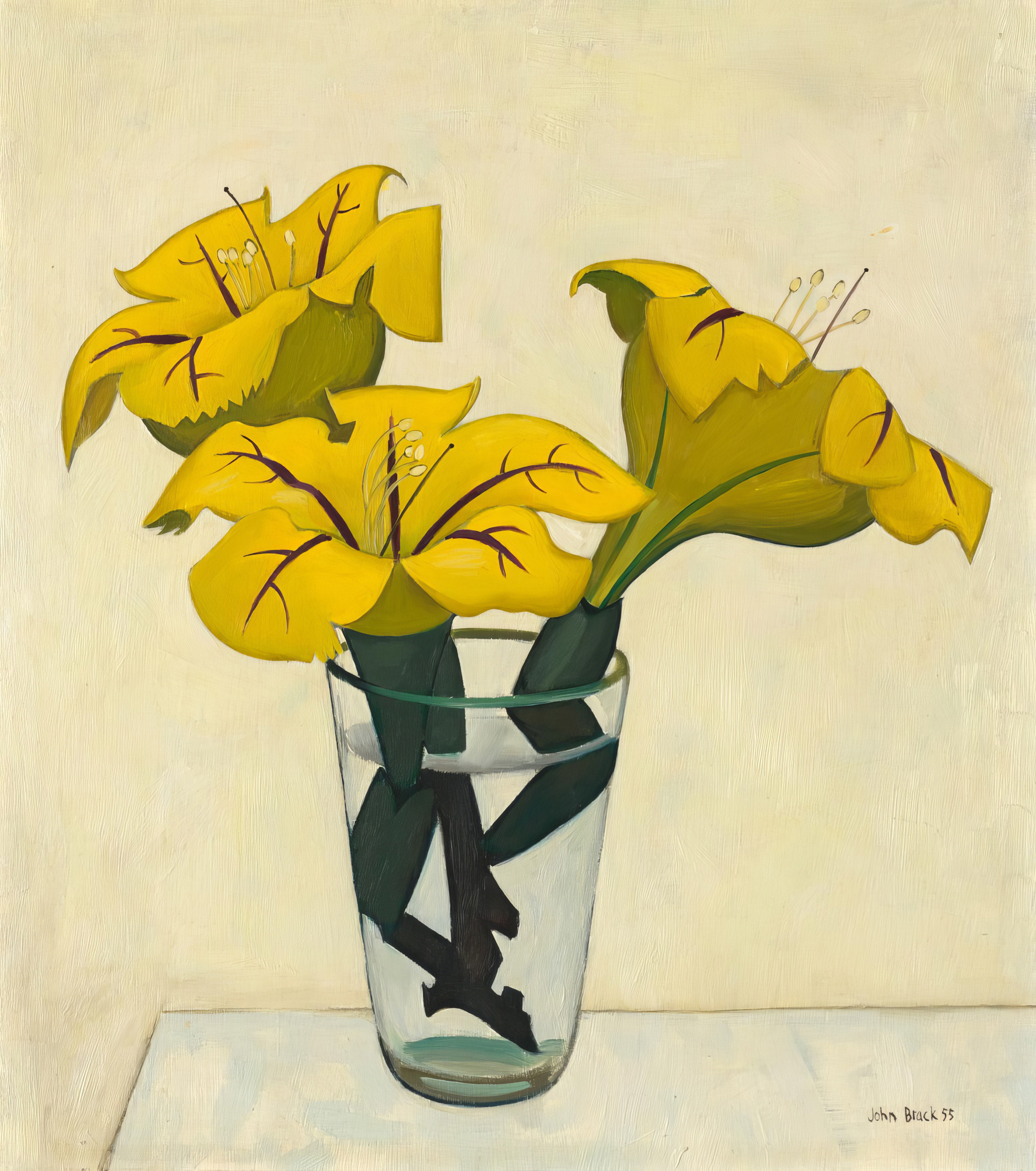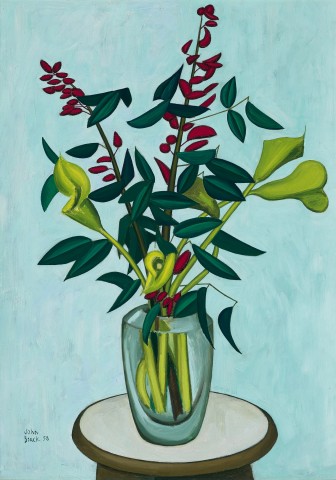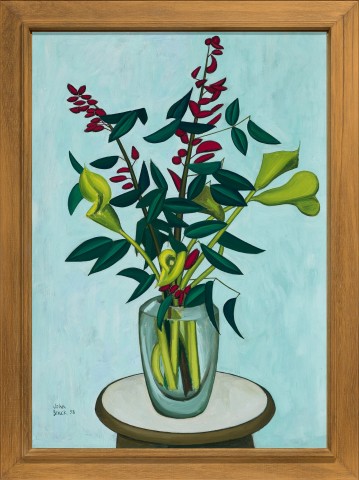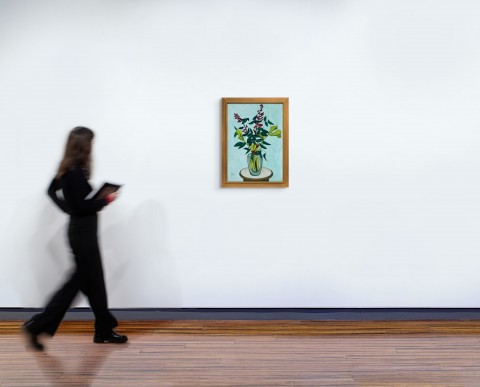FLOWERS AND LEAVES, 1958
JOHN BRACK
oil on canvas
65.5 x 46.0 cm
signed and dated lower left: John / Brack 58
bears inscription verso: Leaves & Flowers
Australian Galleries, Melbourne
Private collection, Melbourne
Australian Galleries Second Anniversary Exhibition, Australian Galleries, Melbourne, 3 – 12 June 1958, cat. 4
Grishin, S., The Art of John Brack, Oxford University Press, Melbourne, 1990, cat. o82, vol. 2, p. 12
250021 John Brack-(cleaned).jpg

Being interviewed by Robert Hughes in 1959, John Brack declared, ‘National style is a thing of the past… I couldn’t care less about Australian Myths and Legends. I suppose bushrangers are very beautiful, but they bore me.’1 Emphasising his perspective on the type of subject matter that was relevant to a local, contemporary audience, Brack continued, ‘there’s only one true sort of Australian painting… and it consists of truthfully reflecting the life we see about us.’2
As a painter of modern life, Brack found the subjects of his art in his immediate surroundings, the suburbs and the city of Melbourne. His best-known paintings of 1950s Australia, such as The new house, 1953 (Art Gallery of New South Wales) and the iconic Collins St, 5p.m., 1955 (National Gallery of Victoria), are full of acute observations of contemporary living, seemingly humorous and ironic – and from an early twenty-first century perspective, certainly also nostalgic. Such images were primarily motivated however, by Brack’s intense interest in people and the human condition. His early resolution to produce an essentially humanist art that engaged directly with the present was supported by his reading of authors including Rainer Maria Rilke, who advised to ‘seek those [themes] which your own everyday life offers you’ and Henry James, who found inspiration for his stories in random events and snippets of overheard conversations.3 As Brack explained, ‘I believed… that you had to decide whether you were going to… take no notice of events or whether you were going to be engaged. Temperamentally, it was obvious I had to be the latter.’4
Brack’s practice of identifying subject matter that was close at hand inevitably resulted in images with a distinctly local flavour – recognisable to anyone who grew up in mid-twentieth century Australia, and especially in Melbourne. Elements of autobiography appear throughout his oeuvre, as do works which continue traditional categories of Western art including portraiture, the nude and still-life. During the 1950s, he addressed the theme of the still-life, focussing on everyday domestic items which were isolated and described in his characteristically cool and analytical style – think, for example, of The hairbrush, 1955 (private collection), or The breakfast table, 1958 (Art Gallery of New South Wales).
250021 John brack_(2) (cleaned).jpg

He also painted simple cut flowers just as you might find them arranged in a vase in a mid-century suburban home. Between 1955 and 1959 Brack produced fourteen floral still life paintings, among others, depicting carnations, chrysanthemums and gerberas, along with Pot plant, 1957 and in 1958, turning his attention to flowering gums in a trio of related paintings. Brack once said that he found the process of painting flowers relaxing and these works, typically small in scale, speak to the simple enjoyment of setting up an arrangement in the studio, observing its overall shape as well as individual details, and describing the scene in paint. Nevertheless, in each painting Brack’s approach appears to respond to the characteristics of the specimen he is depicting; crisp hard-edges and a minimal background for Solandra, 1955 (National Gallery of Victoria) for example, in contrast to a more painterly style for Flowers (Shasta daisies), 1959 (National Gallery of Victoria) which are shown against a loose, textured background that echoes the free-form quality of the blooms and their long, leafy stems.
In Flowers and leaves, 1958 there is a strong focus on form and colour. While the composition is balanced, with the glass vase centrally placed on a small circular table, there is a dynamic visual interplay between the irregular angularity of the branches, with their striking burgundy seed pods, and the organic curves of the lilies. The outlining of objects in black (or very dark) paint which was a hallmark of Brack’s painting during these years, defines the plant forms against a pale background which highlights the vibrant greens, dark burgundy and brown of the plants.
By 1958, Brack had joined the stable of Australian Galleries, one of the few commercial galleries in Melbourne, which had been established two years earlier by Tam and Anne Purves. Flowers and leaves was shown in the Second Anniversary Exhibition alongside several other paintings by Brack, as well as works by other artists including Charles Blackman, Arthur Boyd, Mary Macqueen and Fred Williams. Purchased from that exhibition, it has remained in the hands of the same family ever since.
1. John Brack, cited in Hughes, R., ‘Brack: Anti-Romantic Gad-Fly’ in The Observer, 21 March 1959, p. 182
2. ibid.
3. See Grant, K., ‘Human Nature: The Art of John Brack’ in Grant, K., John Brack, National Gallery of Victoria, Melbourne, 2009, p. 92
4. Brack, J., ‘Brack on Brack’, Council of Adult Education, Discussion Group Art Notes, Melbourne, ref. no. A401, 1957, p. 1
KIRSTY GRANT


